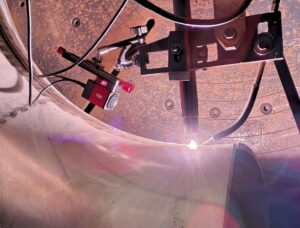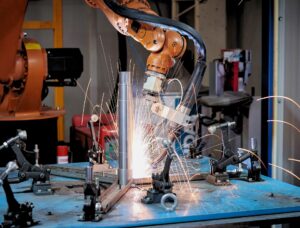Why real-time weld monitoring is becoming essential in nuclear environments
In this blog, we’ll examine welding cameras in nuclear power plants and how specialized monitoring systems are supporting the industry’s rigorous quality, safety, and documentation standards. In nuclear power plants, every weld matters. A single flaw in a weld joint—whether in a pressure vessel, containment piping, or fuel storage system—can have catastrophic consequences. That’s why the industry upholds the most rigorous standards for weld quality, safety, and documentation. As these standards continue to evolve, welding cameras are becoming a vital part of the solution. These specialized tools provide real-time arc monitoring, enhance visual access in restricted areas, and support thorough quality control—all while keeping human inspectors safer and more efficient.
Why Weld Integrity Is So Critical in Nuclear Power Plants
Welds in nuclear plants are not just structural—they are safety-critical components. They’re responsible for sealing radioactive materials, withstanding extreme temperatures and pressure, and resisting corrosion over decades.
Failures in these welds could lead to:
- Radiation leaks
- Environmental contamination
- Costly shutdowns
- Regulatory violations
For this reason, non-destructive testing (NDT), visual inspections, and advanced weld monitoring systems are mandated at every stage of the welding process.
How Welding Cameras Support Safety and Compliance
1. Real-Time Monitoring During Welding
Arc cameras allow operators and inspectors to view the welding process as it happens—capturing fine details like arc behavior, puddle flow, and electrode movement.
This enables:
- Recording for audit and traceability purposes
- Immediate detection of anomalies (e.g., porosity, undercut, arc wandering)
- Live process adjustments to prevent weld defects
2. Enhancing Visibility in Remote or Hazardous Areas
Many welds in nuclear facilities are located in:
- Tight containment zones
- Radiated or high-temperature areas
- Complex pipe systems
Remote welding cameras can be installed on robotic arms, borescopes, or fixtures to give operators a clear line of sight where traditional inspection would be impossible or dangerous.
3. Supporting Automated Welding and Robotics
With the rise of automated welding systems in nuclear plants, welding cameras ensure the robot is performing consistently and correctly.
They help:
- Track joint alignment in real time
- Detect deviations or interruptions in the arc
- Synchronize camera footage with robotic welding logs for quality assurance
4. Improving Post-Weld Analysis and Documentation
Welding cameras can record high-resolution video and data during every weld. This visual evidence supports:
- Regulatory documentation and nuclear code compliance
- Post-weld analysis and training
- Internal audits or third-party inspections
Real-World Applications in Nuclear Welding
- Cladding operations: Cameras monitor overlay welds that protect reactor surfaces from corrosion.
- Pipe-to-pipe welding: Critical for coolant and waste systems, where full penetration is a must.
- Maintenance and retrofit welding: Used during shutdowns and repairs where access is limited and quality must be assured.
In all these cases, cameras offer more than just convenience—they offer a layer of safety and control that’s fast becoming industry standard.
The Role of Weld Cameras in Regulatory Compliance
Regulatory bodies like the U.S. Nuclear Regulatory Commission (NRC) and the American Society of Mechanical Engineers (ASME) require thorough weld inspection protocols. While welding cameras aren’t mandatory in every case yet, they greatly aid in meeting and exceeding visual inspection requirements, especially in:
- ASME Section IX (Welding & Brazing Qualifications)
- Section III (Nuclear Facility Components)
- ISO and AWS codes for weld quality
By integrating weld cameras into your QA/QC system, you’re not only improving safety—you’re future-proofing your processes against rising compliance standards.
Conclusion: Welding Cameras Are Redefining Nuclear Safety Standards
In the high-stakes world of nuclear energy, there’s no room for guesswork or rework. Welding cameras provide the clarity, traceability, and control that today’s critical welds demand. Whether it’s during fabrication, maintenance, or automated welding, these tools ensure that every weld meets the industry’s highest safety and quality expectations.
Interested in integrating weld monitoring into your nuclear welding processes? Contact Mecaweld to explore high-performance welding cameras engineered for nuclear-grade precision.



